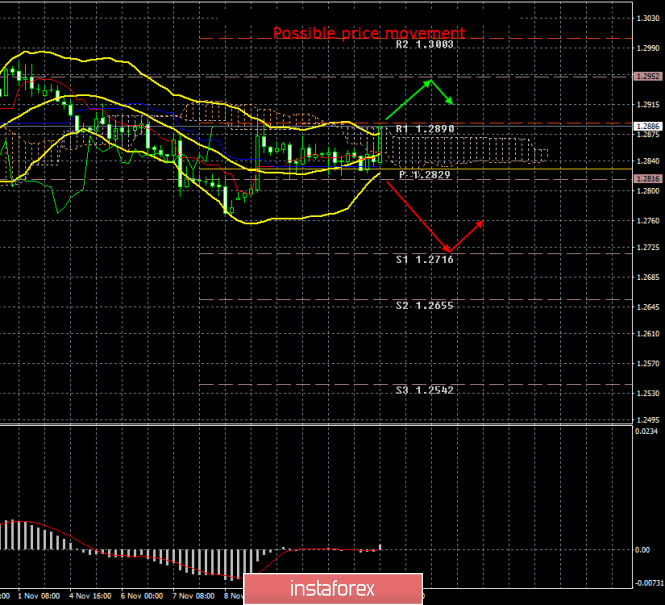4-hour timeframe

Amplitude of the last 5 days (high-low): 84p - 54p - 112p - 58p - 41p.
Average volatility over the past 5 days: 70p (average).
The British pound on Thursday, November 14, stood for most of the day in one place as part of the flat, which we have already written about several times. Even a slight growth during the US trading session cannot indicate the completion of the correction, especially since it is rather difficult to say exactly what caused this surge of emotions among traders. Traders again ignored weak macroeconomic statistics from the UK today, although it was expected that it would finally please traders. However, these hopes were not destined to come true. Retail sales decreased by 0.1% in October compared with the previous month and added 3.1% in annual terms, which is much worse than forecasted. Thus, the pound has not received support, traders just once again did not pay any attention to macroeconomic statistics. But quotes increased in the afternoon, however, this movement can end very quickly, like the previous surge, based on information about the creation of a coalition in the elections between the parties of Boris Johnson and Nigel Faraj.
In fact, there can only be two reasons for a sharp, but not strong fall in the US currency. We covered the first in sufficient detail in an article on the EUR/USD currency pair - this is a possible escalation of the trade conflict between the United States and China and another "dead end" in negotiations on a trade agreement between the countries. The second is Jerome Powell's new congressional statement, this time to the budget committee. However, what could Jerome Powell say such that it would cause a fall in the US currency? It is unlikely that today he hinted at a reduction in the key rate, when after the day before in the same Congress he had almost openly declared that the monetary policy of the Fed would not require intervention in the near future. We will learn about this later, but in any case, we do not believe that the Fed chief said anything extraordinary. Instead of guessing at the coffee grounds about what Powell said, we suggest focusing again on the question "Why do market participants stubbornly ignore macroeconomic statistics from the UK?" If in the case of the euro currency, we said that there was a situation where there is no good reason for new sales or purchases, then in the case of the British pound, this does not work. The GBP/USD pair is far enough from its lows, so traders this week could calmly get rid of the pound again on the basis of all the same failed macroeconomic information that we have witnessed. If the markets really now pay attention only to news of a political nature and on the Brexit topic, then we can explain the complete calm on the pound/dollar pair. After all, there is no news and cannot be any news on the topics identified above. Brexit paused, political parties getting ready for re-election. Parliament dissolved. What kind of news could there be?
Meanwhile, European Council President Donald Tusk called on the British people to continue to fight against Brexit. He said that if Britain exits the European Union, it will become an "outsider and minor player" on the world stage. Donald Tusk leaves his post on December 1 after Mario Draghi and Jean Claude Juncker. If earlier he had to maintain an official position on the Brexit issue, now he can speak more informally. The fact that the EU wants to keep Britain in its composition is not a secret for anyone. In fact, the European Union continues to fight to keep Britain in its composition, not giving it what could lead to the approval by the British Parliament of the deal on Brexit. Well, it all comes down again to the Parliament elections on December 12, from which the future of both Great Britain and the European Union will depend.
The technical picture of the currency pair shows only a full flat, despite the upward movement in the US trading session. Bollinger Bands narrowed to an absolute low and directed to the side. The volatility of the pair decreased to the level of 70 points a day, which is formally an average value, but this is a rather low value for the pound. The pair returned to the area of the Ichimoku cloud, so the uncertainty with the direction of movement became even greater. Thus, from our point of view, this is not the most favorable time to open any position, especially given the complete ignoring by investors of the fundamental background.
Trading recommendations:
The GBP/USD pair finally turned into a sideways movement. Thus, traders are advised to wait until the completion of a flat and the resumption of trend movement. However, it should be recognized that a flat may last several days and several weeks if traders continue to wait for news on Brexit and on the elections to the British Parliament.
Explanation of the illustration:
Ichimoku indicator:
Tenkan-sen is the red line.
Kijun-sen is the blue line.
Senkou Span A - light brown dotted line.
Senkou Span B - light purple dashed line.
Chikou Span - green line.
Bollinger Bands Indicator:
3 yellow lines.
MACD indicator:
Red line and bar graph with white bars in the indicator window.
Support / Resistance Classic Levels:
Red and gray dotted lines with price symbols.
Pivot Level:
Yellow solid line.
Volatility Support / Resistance Levels:
Gray dotted lines without price designations.
Possible price movements:
Red and green arrows.
The material has been provided by InstaForex Company - www.instaforex.com